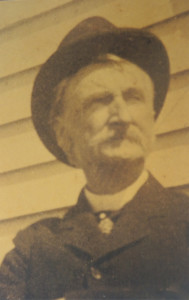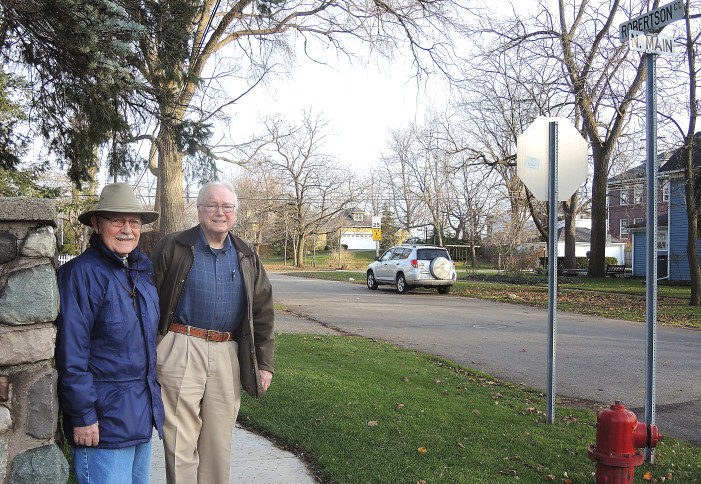Charles Gray Robertson III, at right with neighbor and Clarkston genealogist Tom Stone, on Robertson Court, named after his family. Photo by Phil Custodio
Sixth in a series on the families who helped build Clarkston and the descendants who still live here, carrying on their legacy.
BY PHIL CUSTODIO
Clarkston News Editor
Gangs roamed the streets of Clarkston when Charles Gray Robertson III was growing up, claiming territories around Holcomb Street, Church Street, Middle Lake, and his own Robertson Court.
“Not for anything illegal, but for spirited sporting contests,” said Robertson, 81.
His great grandfather Charles Gray Robertson founded the neighborhood, but that didn’t make Charles the third the leader of the local gang.
“I don’t think it gave much additional respect,” he said.
But Robertson Court did give him lots of stories to share with his children and grandchildren.
“We swam a lot in Parke Lake, a beautuful clean, deep lake,” he said. “As kids, we wondered how deep it was. We decided to make ourselves a diving helmet. We made it out of a galvalized steel pail. We cut a round hole in front, and taped in flashlight lens. On the other side, we made a hose connection, for a garden hose.”

They used a burlap bag of rocks as ballast, with air provided by a guy on shore, pumping a tire pump as fast as he could.
“We couldn’t believe how well it worked,” Robertson said. “We went down 20 feet, and found out it was solid clay down there. Our parents found out about it and thought it was a little bit too dangerous.”
They did lots of things until their parents found out about them, he said.
“One winter, a late January ice storm created a thick crust on top of the snow, over two inches,” he said. “When it started to melt, you could slide down from the north end of the hill off Parke Lake, all the way across to the south end and back. We did that all day long, all the way across the lake, back and forth. It lasted a couple of days.”
Summer also meant outdoor games, mostly sandlot baseball and football sans safety gear, with some basketball thrown in too.
“We’d sneak into the high school, now Renaissance High School, at night. The little guy would go through the window and come around to open the door,” Robertson said. “We didn’t do anything bad. We turned off the lights and locked up after we were done.”
Camping was a popular activity, he remembers, especially in the years right after World War II when there were tons of war surplus material available for pennies on the dollar – tents, sleeping bags, camping stoves, everything they needed.
“Kids did a lot of camping back then. The surrounding area was open territory, so we camped where we wanted to,” he said. “My favorites were the hills and woods around Cranberry Lake, sometimes 2-3 nights. Parents assumed things were alright. It was a very different time.”
Bicycles were the preferred mode of transportation all over the township and beyond, he said.
“Back then, Sashabaw was a fairly narrow dirt road. We’d bike south to the theater in Drayton Plains, watch a matinee, root for our favorite cowboys Roy Rogers, Gene Kelly, Hoppilong, a plethora of heroes, a quarter would buy a ticket, popcorn, and a drink,” Robertson said. “Money went a lot further back then. My brother and I got dime allowance. You could buy two Hershey bars, double size, candy by the armload for 10 cents.”
For extra money, most kids got jobs.
“I was lucky enough to get a paper route, for the Pontiac Daily Press. They would drop off papers outside the dairy bar at the southwest corner of Depot and Main Street,” he said. “It was a teen hangoug, with a juke box, dance floor, pingpong table, pool table. We’d play pool before we got the papers. I needed a note from my mother before I could do that.”
He and a lot of kids also worked as carryout boys for Rudy’s Market on Main Street.
“There were three grocery stores at the time,” he said. “We’d deliver groceries and take them out to cars.”
Residents had quite a few animals in town, even on Main Street.
“Dad had flock of chickens in the second story of the garage, 20 laying hens,” he said. “Unfortunately my job was to feed the chickens and collect the eggs. In winter, I had to thaw out the water troughs and put coal in the furnace before I went to school.”
Downtown residents had cows, sheep, horses, and flocks of chicken.
“I always had a dog,” he said. “One day, my dog Chum killed six chickens. Thank God dad came to the rescue and paid for the chickens, and Chum lived see another day.”
The pooch’s luck eventually ran out, though, and he was run over by a garbage truck, he remembers.
Robertson graduated from Albion College and went to work for the pharmaceuticals company Park Davis. He and his wife, Kay, raised their children Patricia Kay Robertson,Charles Gray Robertson IV, and Gregory Robertson in the “birdland” neighborhood off Maybee Road until his parents passed away, and they moved into the house on Robertson Court.
“We still live there. I hope we live there the rest of our lives,” Robertson said. “One of my sons (Clarles Gray IV) expressed an interest in living there, as did one of my grandsons (Charles Gray V). We may live there another 150 years.”
Robertson Court was always considered home, he said.
“It was nice living in Birdland, but I didn’t have roots there,” he said. “I appreciate the fact we’re living in a rather unique community. It’s something we treasure.”
The Clarkston News and Tom Stone, longtime resident and genealogist, are highlighting every month local families who have lived in the area for at least 100 years.
Family history preserved
The first Charles Gray Robertson, Charles Gray III’s great grandfather, was a pillar of downtown Clarkston after moving there in 1880 with his family.
Charles Gray III wrote about him in a family history so his descendents would know his story.
“I didn’t listen when I was younger, but I’m starting to listen now,” he said. “If you don’t do that, memories fade as time goes on.”
The first Charles Gray was the town doctor, his great grandson wrote. He saw patients on Wednesdays and Saturdays in an office building, since burned, that once stood on Main Street. Often, Dr. Robertson did not receive any money for his care. Instead receiving produce from his patients’ gardens or grain for his horses or poultry such as chicken and geese. To supplement his income he also sold gravel, which was found in abundance on his property, to the village for use on the roads.
Charles Gray Robertson was born Nov. 24, 1829, in Scotland. His family arrived in America at the port of New York City on June 7, 1836, traveled to Detroit via the Erie Canal and Lake Erie, and settled in White Lake.
Great-grandfather Charles remained on the farm until he was 16, when he began to prepare himself for a career in medicine. He taught school during the winter months to earn the money to pay his expenses while pursuing his studies in the summer. In 1850 and 1851 he attended lectures at the Medical College of the University of Michigan and in 1852 he began his practice in Waterford and also operated a drug store there. He was the first resident physician in that village.

On Sept. 13, 1853, he married Jessie Newton at the Hodges House Hotel in Pontiac. The same year he sold his practice in Waterford and hired on as assistance surgeon for the Clift Mines Co. in the Upper Peninsula. He practiced there for three years, but he wasn’t satisfied with the amount of technical knowledge he possessed. So he left to continue his study, and in 1862 he graduated from the Buffalo University of Medicine in New York with a doctor of medicine degree.
Dr. Robertson returned to Waterford to resume his practice, but soon after he decided to join the Union Army during the Civil War. He personally abhorred slavery. He enlisted March 12, 1863, as an assistant surgeon in the Eighth Michigan Cavalry and was promoted to surgeon Sept. 12, 1864. His regiment took part in Gen. William Tecumseh Sherman’s March to the Sea.
On July 31, 1864, near the settlement of Sunshine Church, Georgia, part of Dr. Robertson’s regiment was encircled by the Rebels during Gen. Stoneman’s raid on Macon, Georgia, and he was taken prisoner. The South was still accepting prisoner exchanges and he was released Sept. 3, 1864. He returned to his regiment after 30 days leave.
On another campaign in Tennessee against Confederate Gen. John Bell Hood’s army, he was involved in the Battle of Franklin and Columbia. A correspondent for the Detroit Advertiser and Tribune, Dec. 3, 1864, wrote “too much cannot be said in praise of Surgeon Charles G. Robertson and Assistant Surgeon Samuel D. Toby for their service in caring for our brave wounded boys.”
After the war Dr. Robertson returned to Michigan and set up practice in White Lake, where grandfather Milton Gray Robertson was born on Dec. 17, 1868 and where the family’s original home was located when they first came to America. He remained in White Lake until 1875 and then moved to St. Clair. Still looking for the best location to live and work, he came to Clarkston in 1880 with his wife, Jessie, daughters Ada and Clara, and son Milton.
He purchased eight acres on Main Street next to the Union School property and built a home that stood at the west end of what is now Robertson Court. The rest of the property was used to pasture his horses. Dr. Robertson admired good horses and was an experienced rider, having served in the cavalry. Also, horses were a professional necessity in the 19th century as most of his patients were cared for by house calls.
He was a Mason, belonging to the Clarkston Cedar Lodge No. 60, and a charter member of the Knights of Maccabees.
In 1891, Dr. Clark J. Sutherland, who had just graduated from the University of Michigan Medical School, joined the practice. Together they served the community for 10 years. In July 1901, while helping to mow hay on his small farm, Dr. Robertson, “by over-exertion, some of the tissues about the heart were ruptured, which caused several hemorrhages and resulted in his death,” according to his obituary.
He did not leave much of an estate to his wife, Jessie. However, the U.S. government provided a pension for widows of Civil War veterans. Also, her son Milton, part owner of a profitable department store in Pontiac called Waite Brothers and Robertson, drove out to see her every week, first by horse and buggy and then by automobile, which he was one of the first in the area to own.
After his mother died, Milton subdivided his father’s property, moving the doctor’s home on Main Street to its present location a 10 Robertson Court.
He also built several other houses in the subdivision and Charles Gray III’s father, Charles Gray Robertson II after his grandfather, built two more houses, one of which Charles the third now live.
Dr. Robertson was buried at Lakeview Cemetery in Clarkston. Also in the same plot are his wife, Jessie, his oldest daughter Ada, and one of his sisters, Elizabeth.

